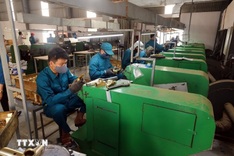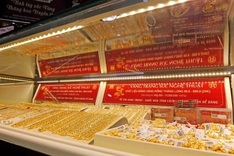
A worker at the Hoa Phat Group.
As foreign exporters increasingly exploit Vietnam as a transshipment hub to bypass trade remedies in third countries, Vietnamese authorities are ramping up efforts to prevent origin fraud and illegal transshipment.
With heightened pressure stemming from US trade policies—particularly following reciprocal tariff measures introduced under President Donald Trump—the need for stricter control over origin labelling has become more urgent than ever. Safeguarding Vietnam’s trade reputation is now a top priority, especially as improper origin claims can jeopardise domestic industries and risk punitive actions from major trading partners.
On April 10, the Ministry of Industry and Trade (MoIT) issued an official directive to tighten control over imported materials used in the production of export goods, reinforcing the government’s commitment to transparent and lawful trade practices.
“Vietnam has consistently pursued a proactive and open-minded approach to trade, working closely with the United States to promote fair trade policies, combat transshipment, and foster mutually beneficial economic relations,” said Deputy Prime Minister Ho Duc Phoc.
The crucial role of rules of origin
Trinh Thi Thu Hien, Deputy Director of the Agency of Foreign Trade under MoIT, underscored the significance of the Rules of Origin (ROO) in determining a product’s eligibility for preferential tariffs under trade agreements.
Under Article 3(b) of the World Trade Organization (WTO) Agreement on Rules of Origin, the country of origin is defined either as the place where the good is wholly obtained or, in cases involving multiple countries, where the last substantial transformation occurs.
Hien clarified a common misconception: the label "Made in Vietnam" does not necessarily equate to a valid Vietnamese Certificate of Origin (C/O), and vice versa. In practice, some goods may carry the label but not meet origin standards, while others may qualify under ROO but not display the label.
To enhance transparency, the Agency of Foreign Trade has been actively refining regulatory frameworks, including issuing clear guidelines on authorised bodies for C/O certification and applying stricter penalties for origin fraud.
The agency also collaborates with C/O-issuing authorities to provide ongoing training and support to businesses, ensuring compliance with origin requirements and facilitating legitimate access to tariff benefits.
When requested, MoIT cooperates with foreign trade authorities to verify the origin of goods, helping to detect cases of minimal processing or mislabelling intended to gain unlawful tariff advantages. Conversely, the agency assists compliant exporters in validating their origin claims and securing preferential treatment.
Efforts are also underway to simplify administrative procedures and adopt digital tools that streamline C/O applications and origin-related inquiries.
Greater transparency and supply chain traceability
As global scrutiny of transshipment intensifies, experts have warned that Vietnam must enhance transparency across its production processes. With the US expected to adopt stricter origin requirements—demanding higher domestic content—Vietnamese exporters could face rising production costs and new compliance challenges.
Nguyen Manh Hung, a logistics and supply chain specialist, emphasised that traceability is critical for confirming the authenticity of Vietnamese products and distinguishing them from rebranded goods originating from third countries.
MoIT has already identified 17 export categories at risk of trade remedy investigations by the US, including sectors vulnerable to allegations of origin fraud and tariff circumvention.
Nguyen Thuong Lang, senior lecturer at the National Economics University, noted that the US possesses advanced monitoring systems and legal instruments to detect and penalise such violations. If caught, exporters could face retroactive tariffs, effectively eroding any competitive advantage.
To mitigate these risks, Lang urged Vietnamese enterprises to increase the localisation rate in their production, ensuring that goods meet origin criteria and are not classified as re-exported products. Greater control over supply chains and use of domestic materials are essential steps forward.
Attracting high-value investment
In tandem with stricter trade enforcement, Vietnam is also reviewing its approach to foreign direct investment (FDI). Dinh Hong Ky, Vice Chairman of the HCM City Union of Business Associations, stressed the need to screen FDI projects more rigorously to avoid approving outdated or low-value processing operations.
“Vietnam should actively seek investment that brings higher added value and contributes to the country’s manufacturing capacity, not just basic assembly or reprocessing,” Ky said.
One furniture exporter in Hai Duong Province shared that despite more than a decade of exporting to the US, the company is now under pressure to provide additional documentation proving the Vietnamese origin of its products. Though the timber is sourced from Yen Bai and paint from Bac Ninh, international partners are demanding detailed traceability records.
In response, several local exporters have begun adopting digital logging systems to track every stage of production—from raw material sourcing to final processing—to bolster confidence in the legitimacy of their goods.
As Vietnam navigates this shifting global trade environment, strengthening regulatory enforcement, improving supply chain transparency, and boosting localisation will be vital for sustaining export growth and maintaining global trust in the "Made in Vietnam" brand.




















